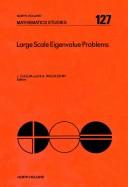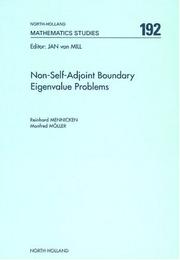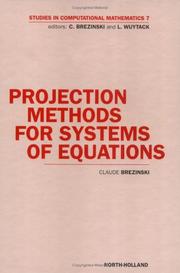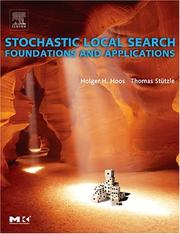| Listing 1 - 10 of 16 | << page >> |
Sort by
|

ISBN: 1281797839 9786611797836 0080872387 0444700749 Year: 1986 Publisher: Amsterdam ; New York : New York, N.Y., U.S.A. : North-Holland ; Sole distributors for the U.S.A. and Canada, Elsevier Science Pub. Co.,
Abstract | Keywords | Export | Availability | Bookmark
 Loading...
Loading...Choose an application
- Reference Manager
- EndNote
- RefWorks (Direct export to RefWorks)
Results of research into large scale eigenvalue problems are presented in this volume. The papers fall into four principal categories:novel algorithms for solving large eigenvalue problems, novel computer architectures, computationally-relevant theoretical analyses, and problems where large scale eigenelement computations have provided new insight.
Eigenvalues --- Data processing --- Matrices --- Congresses
Book
ISBN: 1282702882 9786612702884 0080955983 9780080955988 0127424504 9780127424507 9781282702882 6612702885 Year: 1972 Volume: 89 Publisher: Burlington, Mass. : Academic Press,
Abstract | Keywords | Export | Availability | Bookmark
 Loading...
Loading...Choose an application
- Reference Manager
- EndNote
- RefWorks (Direct export to RefWorks)
In this book, we study theoretical and practical aspects of computing methods for mathematical modelling of nonlinear systems. A number of computing techniques are considered, such as methods of operator approximation with any given accuracy; operator interpolation techniques including a non-Lagrange interpolation; methods of system representation subject to constraints associated with concepts of causality, memory and stationarity; methods of system representation with an accuracy that is the best within a given class of models; methods of covariance matrix estimation;methods for low-rank
Nonlinear systems --- Mathematical models. --- Systems, Nonlinear --- System theory --- Calculus of variations. --- Eigenvalues. --- Calculus of variations --- Eigenvalues

ISBN: 9780444514479 0444514473 9780080537733 0080537731 1281048747 9781281048745 9786611048747 Year: 2003 Publisher: Amsterdam ; Boston : Elsevier,
Abstract | Keywords | Export | Availability | Bookmark
 Loading...
Loading...Choose an application
- Reference Manager
- EndNote
- RefWorks (Direct export to RefWorks)
This monograph provides a comprehensive treatment of expansion theorems for regular systems of first order differential equations and n-th order ordinary differential equations.In 10 chapters and one appendix, it provides a comprehensive treatment from abstract foundations to applications in physics and engineering. The focus is on non-self-adjoint problems. Bounded operators are associated to these problems, and Chapter 1 provides an in depth investigation of eigenfunctions and associated functions for bounded Fredholm valued operators in Banach spaces. Since every n-th orde
Boundary value problems. --- Nonselfadjoint operators. --- Eigenvalues. --- Differential equations.
Book
ISBN: 1282289845 9786612289842 0080955908 0120658011 9780120658015 Year: 1972 Volume: 82 Publisher: New York : Academic Press,
Abstract | Keywords | Export | Availability | Bookmark
 Loading...
Loading...Choose an application
- Reference Manager
- EndNote
- RefWorks (Direct export to RefWorks)
Multiparameter eigenvalue problems
Differential equations. --- Eigenvalues. --- Inverse problems (Differential equations). --- Matrices. --- Operator theory. --- Spectral theory (Mathematics). --- Sturm-Liouville equation. --- Algebras, Linear. --- Compact operators --- Algèbre linéaire --- Matrices --- Opérateurs compacts --- Valeurs propres --- Eigenvalues --- Differential equations

ISBN: 1281763284 9786611763282 0080874347 9780080874340 9781281763280 9780121706401 0121706400 Year: 1984 Volume: 115 Publisher: Orlando : Academic Press,
Abstract | Keywords | Export | Availability | Bookmark
 Loading...
Loading...Choose an application
- Reference Manager
- EndNote
- RefWorks (Direct export to RefWorks)
The basic goals of the book are: (i) to introduce the subject to those interested in discovering it, (ii) to coherently present a number of basic techniques and results, currently used in the subject, to those working in it, and (iii) to present some of the results that are attractive in their own right, and which lend themselves to a presentation not overburdened with technical machinery.
Differential equations, Partial. --- Eigenvalues. --- Geometry, Riemannian. --- Riemann geometry --- Riemannian geometry --- Generalized spaces --- Geometry, Non-Euclidean --- Semi-Riemannian geometry --- Matrices --- Partial differential equations --- Differential equations, Partial --- Eigenvalues --- Geometry, Riemannian --- Equations aux dérivées partielles --- Valeurs propres --- Riemann, Géométrie de
Book
ISBN: 0444821074 9786611059910 1281059919 0080542158 9780444821072 9780080542157 9781281059918 6611059911 Year: 1995 Publisher: Amsterdam ; New York : Elsevier,
Abstract | Keywords | Export | Availability | Bookmark
 Loading...
Loading...Choose an application
- Reference Manager
- EndNote
- RefWorks (Direct export to RefWorks)
Matrix Singular Value Decomposition (SVD) and its application to problems in signal processing is explored in this book. The papers discuss algorithms and implementation architectures for computing the SVD, as well as a variety of applications such as systems and signal modeling and detection. The publication presents a number of keynote papers, highlighting recent developments in the field, namely large scale SVD applications, isospectral matrix flows, Riemannian SVD and consistent signal reconstruction. It also features a translation of a historical paper by Eugenio Beltrami, containing on
Signal processing --- Decomposition (Mathematics) --- Digital techniques --- Congresses --- -Signal processing --- -Academic collection --- #TELE:SISTA --- 519.6 --- 681.3*G13 --- Processing, Signal --- Information measurement --- Signal theory (Telecommunication) --- Mathematics --- Probabilities --- -Congresses --- Computational mathematics. Numerical analysis. Computer programming --- Numerical linear algebra: conditioning; determinants; Eigenvalues; error analysis; linear systems; matrix inversion; pseudoinverses; sparse and very largesystems --- 519.6 Computational mathematics. Numerical analysis. Computer programming --- 681.3*G13 Numerical linear algebra: conditioning; determinants; Eigenvalues; error analysis; linear systems; matrix inversion; pseudoinverses; sparse and very largesystems --- Academic collection --- Digital techniques&delete& --- Decomposition (Mathematics) - Congresses. --- Signal processing - Digital techniques - Congresses --- Decomposition (Mathematics) - Congresses --- Signals --- Processing
Book
ISBN: 3764328657 3034885474 9783764328658 Year: 1993 Publisher: Basel: Birkhäuser,
Abstract | Keywords | Export | Availability | Bookmark
 Loading...
Loading...Choose an application
- Reference Manager
- EndNote
- RefWorks (Direct export to RefWorks)
Assume that after preconditioning we are given a fixed point problem x = Lx + f (*) where L is a bounded linear operator which is not assumed to be symmetric and f is a given vector. The book discusses the convergence of Krylov subspace methods for solving fixed point problems (*), and focuses on the dynamical aspects of the iteration processes. For example, there are many similarities between the evolution of a Krylov subspace process and that of linear operator semigroups, in particular in the beginning of the iteration. A lifespan of an iteration might typically start with a fast but slowing phase. Such a behavior is sublinear in nature, and is essentially independent of whether the problem is singular or not. Then, for nonsingular problems, the iteration might run with a linear speed before a possible superlinear phase. All these phases are based on different mathematical mechanisms which the book outlines. The goal is to know how to precondition effectively, both in the case of "numerical linear algebra" (where one usually thinks of first fixing a finite dimensional problem to be solved) and in function spaces where the "preconditioning" corresponds to software which approximately solves the original problem.
Convergence --- Equations --- Iterative methods (Mathematics) --- Convergence (Mathématiques) --- Itération (Mathématiques) --- Numerical solutions --- Solutions numériques --- 517.98 --- 519.6 --- 681.3*G13 --- Functional analysis and operator theory --- Computational mathematics. Numerical analysis. Computer programming --- Numerical linear algebra: conditioning; determinants; Eigenvalues; error analysis; linear systems; matrix inversion; pseudoinverses; sparse and very largesystems --- 681.3*G13 Numerical linear algebra: conditioning; determinants; Eigenvalues; error analysis; linear systems; matrix inversion; pseudoinverses; sparse and very largesystems --- 519.6 Computational mathematics. Numerical analysis. Computer programming --- 517.98 Functional analysis and operator theory --- Convergence (Mathématiques) --- Itération (Mathématiques) --- Solutions numériques --- Convergence. --- Numerical solutions.

ISBN: 9780444827777 0444827773 0080515258 058547429X 9780585474298 9780080515250 Year: 1997 Volume: 7 Publisher: [Place of publication not identified] Elsevier Science
Abstract | Keywords | Export | Availability | Bookmark
 Loading...
Loading...Choose an application
- Reference Manager
- EndNote
- RefWorks (Direct export to RefWorks)
The solutions of systems of linear and nonlinear equations occurs in many situations and is therefore a question of major interest. Advances in computer technology has made it now possible to consider systems exceeding several hundred thousands of equations. However, there is a crucial need for more efficient algorithms.
The main focus of this book (except the last chapter, which is devoted to systems of nonlinear equations) is the consideration of solving the problem of the linear equation
The book is intended for students and researchers in numerical analysis and for practitioners and engineers who require the most recent methods for solving their particular problem.
Lineaire vergelijkingen. --- Projectiemethoden (wiskunde) --- Equations, Simultaneous --- Iterative methods (Mathematics) --- Itération (Mathématiques) --- Numerical solutions. --- -Iterative methods (Mathematics) --- #TELE:SISTA --- 519.6 --- 681.3*G13 --- Iteration (Mathematics) --- Numerical analysis --- Simultaneous equations --- Numerical solutions --- Computational mathematics. Numerical analysis. Computer programming --- Numerical linear algebra: conditioning; determinants; Eigenvalues; error analysis; linear systems; matrix inversion; pseudoinverses; sparse and very largesystems --- 681.3*G13 Numerical linear algebra: conditioning; determinants; Eigenvalues; error analysis; linear systems; matrix inversion; pseudoinverses; sparse and very largesystems --- 519.6 Computational mathematics. Numerical analysis. Computer programming --- Mathematics --- Physical Sciences & Mathematics --- Algebra --- Equations, Simultaneous - Numerical solutions.
Book
ISBN: 0126856508 9780126856507 9780080956084 0080956084 1282290215 9781282290211 9786612290213 Year: 1973 Volume: 99 Publisher: New York: Academic press,
Abstract | Keywords | Export | Availability | Bookmark
 Loading...
Loading...Choose an application
- Reference Manager
- EndNote
- RefWorks (Direct export to RefWorks)
Sparse matrices
Numerical analysis --- Sparse matrices. --- Matrices éparses. --- Analyse numérique. --- Algèbre linéaire. --- Algebras, Linear --- Matrices --- Algebra, Universal. --- Data processing. --- Data processing --- 519.6 --- 681.3*G13 --- 681.3*G13 Numerical linear algebra: conditioning; determinants; Eigenvalues; error analysis; linear systems; matrix inversion; pseudoinverses; sparse and very largesystems --- Numerical linear algebra: conditioning; determinants; Eigenvalues; error analysis; linear systems; matrix inversion; pseudoinverses; sparse and very largesystems --- 519.6 Computational mathematics. Numerical analysis. Computer programming --- Computational mathematics. Numerical analysis. Computer programming --- Algebra, Multiple --- Multiple algebra --- N-way algebra --- Universal algebra --- Algebra, Abstract --- Numbers, Complex --- Analyse numérique --- Algèbre linéaire --- Numerical analysis. --- Algebras, Linear. --- Matrices - Data processing --- Calcul matriciel --- Methodes numeriques

ISBN: 9781558608726 1558608729 1493303732 9786611015053 1281015059 0080498248 9780080498249 9781281015051 6611015051 Year: 2005 Publisher: San Francisco: Morgan Kaufmann,
Abstract | Keywords | Export | Availability | Bookmark
 Loading...
Loading...Choose an application
- Reference Manager
- EndNote
- RefWorks (Direct export to RefWorks)
Stochastic local search (SLS) algorithms are among the most prominent and successful techniques for solving computationally difficult problems in many areas of computer science and operations research, including propositional satisfiability, constraint satisfaction, routing, and scheduling. SLS algorithms have also become increasingly popular for solving challenging combinatorial problems in many application areas, such as e-commerce and bioinformatics.Hoos and Stützle offer the first systematic and unified treatment of SLS algorithms. In this groundbreaking new book, they examine the
Stochastic programming --- Algorithms --- Combinatorial analysis --- Programmation stochastique --- Algorithmes --- Analyse combinatoire --- 681.3*G13 --- Numerical linear algebra: conditioning; determinants; eigenvalues and eigenvectors; error analysis; linear systems; matrix inversion; pseudoinverses; singular value decomposition; sparse, structured, and very large systems (direct and iterative methods) --- Linear programming --- Combinatorics --- Algebra --- Mathematical analysis --- Algorism --- Arithmetic --- Foundations --- Algorithmes. --- Programmation stochastique. --- Analyse combinatoire. --- Algorithms. --- Combinatorial analysis. --- Stochastic programming.
| Listing 1 - 10 of 16 | << page >> |
Sort by
|

 Search
Search Feedback
Feedback About UniCat
About UniCat  Help
Help News
News